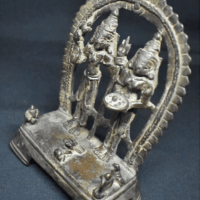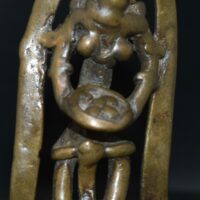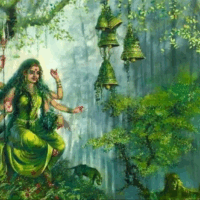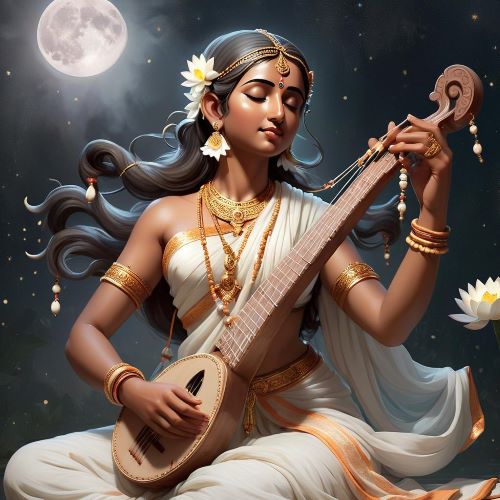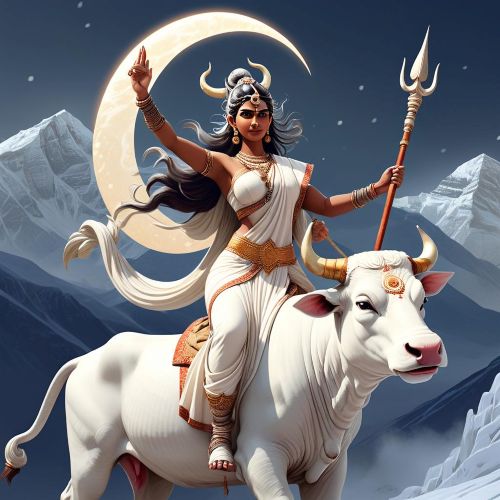Aranyani : Goddess of Forests
Listen
At a glance
| Description | |
|---|---|
| Origin | Indian Mythology |
| Classification | Gods |
| Family Members | N/A |
| Region | India |
| Associated With | Forests, Wildlife |
Aranyani
Introduction
Aranyani, the enigmatic goddess of forests in Hindu mythology, personifies the spirit of nature in its most untouched form. She is revered not in towering temples or bustling cities, but in the serene heart of the jungle where sunlight filters through thick canopies and every leaf whispers a sacred tale. Unlike deities associated with power or war, Aranyani is a nurturing, mysterious presence—mother to the animals, guardian of the wild, and silent provider of food and shelter to humankind. Her origins trace back to a divine moment between Shiva and Parvati under the Kalpavriksha tree, where a desire for beauty and virtue gave rise to her ethereal form. A hymn in the Rig Veda’s tenth Mandala, specifically Hymn 146, immortalizes her elusive nature and sacred role.
Physical Traits
Though seldom seen by human eyes, Aranyani’s presence is unmistakable to those who wander deep into the forest. Her movements are often betrayed by the faint jingling of anklets as she dances lightly over fallen leaves. The scriptures describe her as luminous and graceful, with golden hair crowned with a garland of wild blossoms and a face glowing like the sun. Clad in petals and vines, she blends seamlessly into the living landscape she protects. She speaks not with words, but through the sounds of nature—cicadas chirping at dusk, the rustle of trees, or the distant roar of a jungle beast. Her form, both delicate and commanding, represents the soul of the forest—beautiful, elusive, and profoundly sacred.
Family
Born of divine intent rather than traditional lineage, Aranyani’s story begins with a wish from Parvati under the wish-fulfilling Kalpavriksha. Moved by the tree’s allure, Parvati longed for a daughter imbued with nine divine virtues, and with Shiva’s breath, Aranyani emerged as a living embodiment of that wish. Though she is not associated with a husband or children in most myths, Aranyani is seen as the universal mother of forest creatures. The Kalpavriksha itself, which granted her existence, is often depicted as being under her care, surrounded by celestial beings and mythic animals. This maternal essence connects her not only to plants and animals but to the divine cycle of creation and preservation that sustains life in the wild.
Other names
The name Aranyani comes from the Sanskrit word Aranya, meaning “forest” or “wilderness.” The suffix “-ni” feminizes the term, marking her as the female spirit of the wild. In various traditions, she is also known as Vanadevi, the goddess of the woods, and sometimes referred to as the Forest Queen. Though not widely mentioned by alternate titles in modern worship, her identity is firmly rooted in this elemental connection to untamed nature. Unlike other deities whose names shift with region and dialect, Aranyani’s identity remains closely tied to the very essence of her domain. She exists not as a changing myth, but as a constant guardian of the ancient forests.
Powers and Abilities
Aranyani’s strength lies not in overt displays of force, but in her subtle, enduring influence over the ecosystem she governs. She sustains all who dwell in the forest—plant, animal, and even man—without the need for cultivation or harvest. Nature flourishes around her effortlessly. Her protection is passive but potent; she is described as harmless unless provoked by violence or desecration. The hymns declare that she does not kill unless a murderous enemy appears, affirming her peaceful yet vigilant nature. Her presence inspires harmony among living beings, and her dance is believed to maintain the balance of life in the jungle. Her anklets, which ring out like forest music, are symbolic of her mystical bond with the earth and sky, allowing her to move unseen and unheard when she wills it.
Modern Day Influence
Though largely absent from mainstream worship today, Aranyani’s influence is far from lost. In India, the practice of preserving sacred groves—patches of forest protected for religious or cultural reasons—echoes her ancient reverence. These groves, numbering in the thousands, are scattered across the country and serve as living temples to forest deities like Aranyani. They remain untouched by development and serve as critical ecological sanctuaries, reinforcing the goddess’s role in conservation and natural harmony.
Her legacy also finds subtle echoes in modern culture and design. One notable example is the luxury brand Aranyani, which draws inspiration from the goddess in its ethos and artistry. Founded with a vision of sustainability and traditional craftsmanship, the brand celebrates nature’s abundance and the quiet power of heritage—values that align deeply with Aranyani’s spirit.
Contemporary literature and media are gradually revisiting lesser-known deities like Aranyani through feminist and ecological lenses. Writers reinterpret ancient myths to reflect modern values, presenting figures like her as symbols of feminine strength, environmental stewardship, and inner peace. While Aranyani may not headline religious festivals, her symbolic presence is felt wherever forests are protected, nature is honored, or women’s roles in myth are reimagined.
In broader spiritual circles, Aranyani represents a return to simplicity and balance—ideas increasingly cherished in a world struggling with environmental degradation. Her story reminds us that divinity resides not only in the heavens but in the roots of trees, the whisper of the wind, and the soil beneath our feet. The forests she watches over are not just habitats; they are sacred spaces, breathing testaments to life’s interconnectedness.
Related Images
Source
The Goddess Garden. (2018, November 27). Hindu Goddess Aranyani. https://thegoddessgarden.com/hindu-goddess-aranyani/
Ramana Maharshi. Aranyani: The Goddess of Forests and Wilderness. https://www.ramana-maharshi.org/aranyani-the-goddess-of-forests-and-wilderness/
Wikipedia. Aranyani. https://en.wikipedia.org/wiki/Aranyani
Ayra. (2024, May 23). Aranyani. https://ayra.social/core/article/aranyani-0014fadf-e997-4ca6-b71c-77659a7c7ee9-en
The Jai Jais. (2021, March 21). International Day of Forests Goddess Aranyani. https://thejaijais.com/blogs/sunitas-blog/international-day-of-forests-goddess-aranyani
Wisdomlib. (2024, September 3). Description of Goddess Aranyani. https://www.wisdomlib.org/hinduism/essay/goddesses-from-the-samhitas-to-the-sutras/d/doc1457770.html
Fandom. Archetype:Hindu Deity | Superpower Wiki. https://powerlisting.fandom.com/wiki/Archetype:Hindu_Deity
Amarchitrakatha. (2021, May 28). Lesser-Known Goddesses of Indian Mythology. https://www.amarchitrakatha.com/mythologies/lesser-known-goddesses-of-indian-mythology/?srsltid=AfmBOoopYNm_D02_9rGzUNcQh1uXDquqnHeoanq6k3rMIQ0X1kn0VHRs
Earthstoriez. (2016, June 28). INDIA: On the Banyan Tree. https://earthstoriez.com/india-banyan-legend-myth-use
Frequently Asked Questions
What is lorem Ipsum?
I am text block. Click edit button to change this text. Lorem ipsum dolor sit amet, consectetur adipiscing elit. Ut elit tellus, luctus nec ullamcorper mattis, pulvinar dapibus leo.
What is lorem Ipsum?
I am text block. Click edit button to change this text. Lorem ipsum dolor sit amet, consectetur adipiscing elit. Ut elit tellus, luctus nec ullamcorper mattis, pulvinar dapibus leo.
What is lorem Ipsum?
I am text block. Click edit button to change this text. Lorem ipsum dolor sit amet, consectetur adipiscing elit. Ut elit tellus, luctus nec ullamcorper mattis, pulvinar dapibus leo.
What is lorem Ipsum?
I am text block. Click edit button to change this text. Lorem ipsum dolor sit amet, consectetur adipiscing elit. Ut elit tellus, luctus nec ullamcorper mattis, pulvinar dapibus leo.
What is lorem Ipsum?
I am text block. Click edit button to change this text. Lorem ipsum dolor sit amet, consectetur adipiscing elit. Ut elit tellus, luctus nec ullamcorper mattis, pulvinar dapibus leo.



